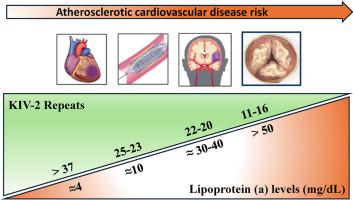脂蛋白(a)与动脉粥样硬化负担--我们是否应等待临床试验证据后再采取行动?
IF 2.1
Q3 PERIPHERAL VASCULAR DISEASE
引用次数: 0
摘要
脂蛋白(a)水平应被视为动脉粥样硬化性心血管疾病(ASCVD)的一个因果残余危险因素,这一点现在已毋庸置疑。这篇综述文章旨在总结支持脂蛋白(a)在 ASCVD 中的因果作用的最新证据,以及在临床试验结果出来之前减轻脂蛋白(a)负担的潜在策略。流行病学和遗传学数据证明了脂蛋白(a)与 ASCVD 风险增加之间的因果关系。尽管如此,我还是想到了一个具体的问题:"我们是否必须等到临床试验结果出来后才能采取行动?鉴于脂蛋白(a)水平在一级和二级预防中都能预测急性心血管疾病的发生,且其分布呈线性风险梯度,因此测量脂蛋白(a)能明确帮助识别日后可能从特定的降低脂蛋白(a)疗法中获益的患者。基于这一认识,多个国家学会建议对高危人群使用脂蛋白(a)剂量,并支持对每个成年人至少测量一次脂蛋白(a)水平以进行风险分层的建议。本文章由计算机程序翻译,如有差异,请以英文原文为准。

Lipoprotein(a) and the atherosclerotic burden – Should we wait for clinical trial evidence before taking action?
The fact that lipoprotein(a) levels should be regarded as a causal residual risk factor in the atherosclerotic cardiovascular diseases (ASCVD) is now a no-brainer. This review article aims to summarize the latest evidence supporting the causal role of lipoprotein(a) in ASCVD and the potential strategies to reduce the lipoprotein(a) burden until clinical trial results are available. Epidemiological and genetic data demonstrate the causal link between lipoprotein(a) and increased ASCVD risk. That being said, a specific question comes to mind: “must we wait for outcome trials in order to take action?”. Given that lipoprotein(a) levels predict incident ASCVD in both primary and secondary prevention contexts, with a linear risk gradient across its distribution, measuring lipoprotein(a) can unequivocally help identify patients who may later benefit from specific lipoprotein(a)-lowering therapies. This understanding has led various National Societies to recommend dosing lipoprotein(a) in high-risk individuals and to support the recommendation of measuring lipoprotein(a) levels at least once in every adult for risk stratification.
求助全文
通过发布文献求助,成功后即可免费获取论文全文。
去求助
来源期刊

Atherosclerosis plus
Cardiology and Cardiovascular Medicine
CiteScore
2.60
自引率
0.00%
发文量
0
审稿时长
66 days
 求助内容:
求助内容: 应助结果提醒方式:
应助结果提醒方式:


